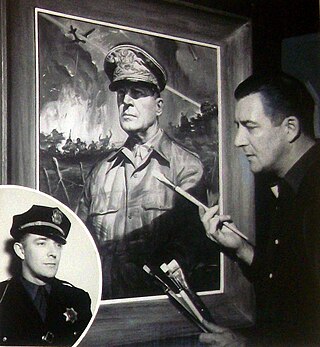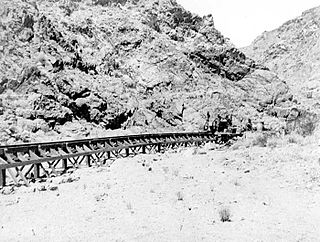
San Pedro is a neighborhood within the City of Los Angeles, California. Formerly a separate city, it consolidated with Los Angeles in 1909. The Port of Los Angeles, a major international seaport, is partially located within San Pedro. The district has grown from being dominated by the fishing industry, to a working-class community within the city of Los Angeles, to a rapidly gentrifying community.

The Drum Barracks, also known as Camp Drum and the Drum Barracks Civil War Museum, is the last remaining original American Civil War era military facility in the Los Angeles area. Located in the Wilmington section of Los Angeles, near the Port of Los Angeles, it has been designated as a California Historic Landmark, a Los Angeles Historic Cultural Monument and has been listed on the National Register of Historic Places. Since 1987, it has been operated as a Civil War museum that is open to the public.

The Salt Lake City Union Pacific Depot is a building on the western edge of downtown Salt Lake City, Utah, United States. Built in 1908–09, it dates back to the more prosperous era in the history of American railroad travel. As Salt Lake Union Pacific Railroad Station, it is listed on the National Register of Historic Places.

Old Las Vegas Mormon Fort State Historic Park is a state park of Nevada, containing the Old Mormon Fort, the first structure built by people of European heritage in what would become Las Vegas fifty years later. In present-day Las Vegas, the site is at the southeast corner of Las Vegas Boulevard and Washington Avenue, less than one mile north of the downtown area and Fremont Street. This is the only U.S. state park located in a city that houses the first building ever built in that city. The fort was listed on the National Register of Historic Places on February 1, 1972. The site is memorialized with a tablet erected by the Church of Jesus Christ of Latter-day Saints in 1997, along with Nevada Historical Marker #35, and two markers placed by the Daughters of Utah Pioneers.

The Warner Grand Theatre is a historic movie palace that opened on January 20, 1931. It is located in San Pedro, Los Angeles, California, at 478 West 6th Street.

Searles Lake is an endorheic dry lake in the Searles Valley of the Mojave Desert, in northwestern San Bernardino County, California. The lake in the past was also called Slate Range Lake and Borax Lake.

Fort Mason, in San Francisco, California originated as a coastal defense site during the American Civil War. The nucleus of the property was owned by John C. Frémont and disputes over compensation by the United States continued into 1968. In 1882 the defenses were named for Richard Barnes Mason, a military governor before statehood. Fort Mason became the headquarters for an Army command that included California and the Hawaiian Islands from 1904 to 1907. In 1912 the Army began building a port facility with piers and warehouses to be a home base for ships of the Army Transport Service serving Alaska, Hawaii, the Philippines and other Pacific Army posts and focus of Army supply for the Pacific.

The Trona Railway is a 30.5 mi (49.1 km) short-line railroad owned by Searles Valley Minerals. The TRC interchanges with the Lone Pine Subdivision of the Union Pacific Railroad at Searles, California.

Fort MacArthur is a former United States Army installation in San Pedro, Los Angeles, California. A small section remains in military use by the United States Air Force as a housing and administrative annex of Los Angeles Air Force Base. The fort is named after Lieutenant General Arthur MacArthur. His son, Douglas MacArthur, would later command American forces in the Pacific during World War II.

Los Angeles Harbor Light, also known as Angels Gate Light, is a lighthouse in California, United States, at San Pedro Breakwater in Los Angeles Harbor, California. The lighthouse is listed on the National Register of Historic Places. It is listed as Los Angeles Light in the USCG Lights list. It is the only lighthouse in the world that emits an emerald-colored light.

The Los Angeles Maritime Museum is a non-profit maritime museum, located at Sixth Street at Harbor Boulevard in the community of San Pedro, in Los Angeles, California.

Searles Valley Minerals Inc. is a raw materials mining and production company with corporate offices in Overland Park, Kansas. It is owned by the Indian company Nirma. It has major operations in the Searles Valley and in Trona, California where it is the town's largest employer. The company produces borax, boric acid, soda ash, salt cake, and salt. It also owns the Trona Railway.

U.S. Post Office in San Pedro, California is a historic Streamline Moderne post office built in 1936. Designed by supervising architect Louis A. Simon with architects Gordon Kaufmann and W. Horace Austin, the San Pedro Post Office was listed in the National Register of Historic Places in 1985. The building also formerly served as a U.S. Customs Office. The building's use of marble, bronze and milk glass are typical of 1930s architecture for U.S. government buildings. The floor tile is laid in a basketweave pattern surrounded by black marble, giving the effect of rugs on a marble floor. Some of the original bronze lamps and ink wells are still intact at the public writing desks. The Section of Painting and Sculpture commissioned Fletcher Martin to create the post office mural, titled Mail Transportation (1938).

San Pedro Municipal Ferry Building is a former Los Angeles Harbor Department ferry terminal building located at Sixth Street at Harbor Boulevard in the community of San Pedro in Los Angeles, California.

Trona is an unincorporated community in San Bernardino County, California. In 2015 it had a population of approximately 1,900. Trona is at the western edge of Searles Lake, a dry lake bed in Searles Valley, southwest of Death Valley. The town takes its name from the mineral trona, abundant in the lakebed. It is about 170 miles (274 km) northeast of Los Angeles, on State Route 178. The ZIP code is 93562.

Harbor View House, formerly the Army and Navy Y.M.C.A., is a Los Angeles Historic-Cultural Monument located in the San Pedro section of Los Angeles, California, near the Port of Los Angeles. It is a five-story Spanish Colonial Revival style structure located on a bluff overlooking the harbor.

Jay Meuser was an American abstract expressionist painter. Meuser's style was versatile and his works prolific. In his lifetime he worked as an illustrator, portrait painter and cartoonist for several newspaper editorial pages.

The Epsom Salts Monorail or Magnesium Monorail was a short-lived Lartigue Monorail in San Bernardino County, California, in the United States. It was built to carry epsomite from a deposit in the Owlshead Mountains to a siding of the Trona Railway. It ran nearly due east from Trona, for a distance of about 28 mi (45 km). The monorail was opened in 1924 and closed in June 1926.

The Potash wars were a series of events that took place from 1910 to 1915 in the Searles Valley near Searles Lake, a dry lake, near the current town of Trona in the San Bernardino County of California. The Potash wars gained national and international news at the time due to the involvement of famous lawman Wyatt Earp and the importance of the valley's supply of potash at the time. Potash is an important crop fertilizer and the Searles Valley was a major supplier in the 1910s.























